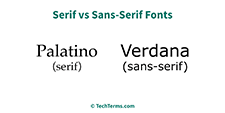Font
A font is a collection of characters with a similar design. These characters include lowercase and uppercase letters, numbers, punctuation marks, and symbols.
Changing the font can alter the look and feel of a block of text. Some fonts are designed to be simple and easy to read, while others are designed to add a unique style to the text. For example, Arial has a simple, modern look, while Palatino has an older more traditional appearance.
Serif vs Sans-Serif Fonts
The two most basic categories of fonts are "serif" and "sans-serif." Small extensions on the edges of characters, such as horizontal line on the bottom of a capital "T," are called serifs. Fonts that include these small lines are called serif fonts. The word "sans" means "without," so sans-serif fonts do not have these extra lines. Generally, serif fonts have a traditional appearance and are often used in printed books and newspapers. Sans-serif fonts have a more modern look and are commonly used on the web.
Most word processors allow you to select a font from a "Fonts" drop-down menu in the toolbar. You can apply a font to an entire document or to a section of highlighted text. In order to use a font, it must be installed on your computer. In Windows, you can add or remove fonts using the Fonts control panel, located in Control Panel → Appearance and Personalization → Fonts. In macOS, you can manage fonts using Font Book, located in the /Applications directory.
Font vs Typeface
Originally, the term "font" referred to a specific size and style of a typeface. For example, Verdana was a typeface and Verdana 16px bold would be a specific font. However, in recent years, the terms have been used interchangeably, with companies like Microsoft, Apple, and Google all using the term "font" to describe a typeface. Therefore, it is acceptable to refer to a typeface such as Roboto as a font.
 Test Your Knowledge
Test Your Knowledge